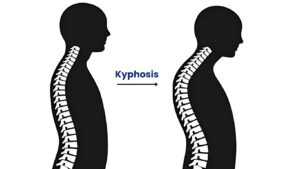
Kyphosis treatment: Causes, Symptoms, and Treatment Options for a Healthier Spine
Introduction
Have you ever noticed someone with a rounded upper back or felt stiffness in your spine after long hours of sitting? This could be a sign of kyphosis, a condition where the spine curves abnormally forward. While a slight curve is normal, excessive curvature can lead to discomfort, pain, and even long-term complications. In this blog, we’ll explore what kyphosis is, its causes, symptoms, and available treatment options to help you maintain a healthy spine.
What is Kyphosis?
An excessive forward rounding of the upper back is called kyphosis. Although some curvature is acceptable for a healthy spine, it is deemed abnormal when the angle is too noticeable (beyond 40 to 45 degrees). In extreme situations, this may result in movement problems, discomfort, and altered posture.
Kyphosis comes in three primary forms:
1. The most prevalent kind, postural kyphosis, is frequently brought on by slouching or bad posture. Exercises and improved postural habits can generally reverse it.
2. A disorder known as Scheuermann’s Kyphosis causes the vertebrae to grow unevenly, which makes the spinal curvature more stiff. Usually, this happens in adolescence.
3. Congenital kyphosis is a congenital condition in which the spine does not develop normally, necessitating early medical intervention.
Causes of Kyphosis
Several factors can contribute to kyphosis, including:
1. Bad Posture: slouching over extended periods of time, particularly when using a computer or a cell phone.
2. Osteoporosis and ageing: As bones weaken, the spine may compress, gradually becoming more curved.
3. Spinal Injuries: Trauma or fractures may cause the spine to become misaligned.
4. Degenerative Disc Disease: The spine may bend forward as a result of the normal deterioration of the spinal discs.
5. Congenital Spine Conditions: Some persons have structural abnormalities in their spines from birth.
Kyphosis symptoms
The following are typical indicators of kyphosis, however they can vary in severity:
✔️ A noticeable forward rounding of the upper back
✔️ Back discomfort and stiffness
✔️ Fatigue from muscle strain
✔️ In more severe cases, breathing difficulties or digestive problems (due to compression on organs)
It’s advisable to see a doctor if you experience chronic back discomfort or an unusual posture that doesn’t go away with stretching.
How is Kyphosis Diagnosed?
Physicians evaluate spinal curvature (Cobb angle) using X-rays and imaging tests, check posture and flexibility with a physical examination, and perform MRI or CT scans if there is a suspicion of nerve injury or structural problems.
Options for Kyphosis Treatment
1. Non-Surgical Interventions
The majority of kyphosis instances, particularly those that are mild to moderate, can be treated without surgery. Typical methods include the following:
✔️ Physical therapy and posture correction: strengthening back muscles and enhancing spinal alignment.
✔️ Pain Management: Pain can be reduced with medication, massage, and heat/cold therapy.
✔️ Bracing (For Adolescents) – A spinal brace can help prevent worsening of Scheuermann’s kyphosis.
✔️ Lifestyle Adjustments – Proper ergonomic support while sitting and regular movement to avoid prolonged strain on the spine.
2. Surgical Treatments (For Severe Cases)
Surgery may be necessary for severe cases of kyphosis (usually above 70 to 80 degrees curvature) that cause pain or breathing difficulties. The most common procedure is spinal fusion, which involves using metal rods and bone grafts to straighten and stabilize the spine. As surgery carries risks, it is only considered when all other options have failed.
Conclusion
Although kyphosis is a common spinal ailment, it can be effectively controlled with the correct care. A proactive approach can assist maintain spinal health, whether through physical therapy, posture modification, or in extreme circumstances, medical intervention.
Don’t ignore chronic back pain or poor posture; get help from a doctor and start on the path to a healthier spine!

